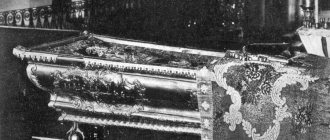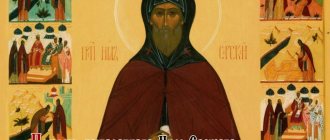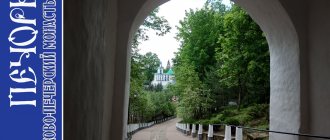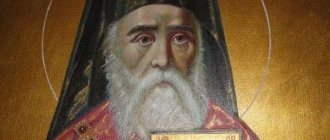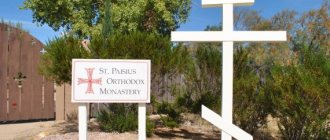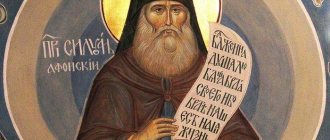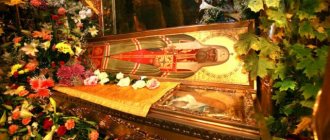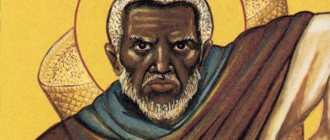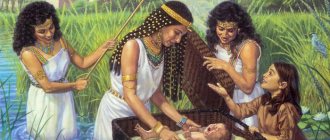| St. Neil Stolobensky |
Nil Stolobensky
[1] (+ 1554), venerable Memory May 27 - discovery of relics in 1667, December 6 (Greek [2]), December 7 and in the Cathedral of Tver Saints
Born into a peasant family in a small village of the Novgorod diocese. In 1505, he became a monk at the monastery of St. Savva of Krypetsky near Pskov.
After 10 years of ascetic life in Konovia, he retired to the Seremlya River, towards the city of Ostashkov, where for 13 years he led a strict ascetic life in continuous battle with the machinations of the devil, which were expressed in the appearance of ghosts - reptiles and wild animals. Many residents from the surrounding areas began to come to the monk for instructions, but he began to feel burdened by this and prayed to God to show him a place for the feat of silence. One day, after a long prayer, he heard a voice: “Nile! Go to Lake Seliger. There on Stolobensky Island you can be saved!” From the people who came to him, the Monk Neil learned where the lake was, and, having arrived there, he was amazed by its beauty. In the middle of the lake is an island covered with dense forest; on it the monk found a small mountain and dug a cave, and after some time he built a hut, in which he lived for 26 years. He accompanied the feats of strict fasting and silence with another, special feat - he never went to bed, but allowed himself only a light nap, leaning on hooks embedded in the wall of the cell.
The saint's godly life many times aroused the envy of the enemy, which manifested itself through the anger of the local residents. One day, someone set fire to the forest on the island where the saint’s hut stood, but the flames, reaching the mountain, miraculously died out. Another time, robbers broke into the hut. The monk told them: “All my treasure is in the corner of the cell.” There stood an icon of the Mother of God. The robbers began looking for money and went blind. Then, in tears of repentance, they began to pray to the saint for forgiveness. Many other miracles performed by the saint are also known. He silently refused offerings if those who came to him had an unclean conscience or were in bodily uncleanness.
| St. Nil Stolobensky (Stolbensky). Icon |
In anticipation of his death, the Monk Neil prepared a coffin for himself.
And at the very time of his repose, the abbot of one of the nearby monasteries arrived on the island and introduced him to the Holy Mysteries. After the departure of the abbot, the Monk Neil prayed for the last time, poured the holy icons and cell, and gave up his immortal soul to the Lord on December 7, 1554. After the death of St. Neil, monks from various monasteries came to Stolobny Island, wandered to holy places, and lived in his cell for some time. Abbot Anthony and monk Herman built a tomb over the grave of the monk, at which healings of the sick were performed even before the foundation of the monastery. Around 1590, the monk Herman settled on the island where the wanderer Boris Kholmogorets lived at that time. With the blessing of Metropolitan Alexander of Novgorod (1576-1591), they built a wooden church in honor of the Epiphany with a chapel in the name of Blessed Basil, Christ for the Fool's sake, the Moscow Wonderworker (+ 1557).
Soon a monastery with a communal charter arose, which was called the Nile Hermitage. Its first rector was Hieromonk Herman.
In 1595, the icon painter monks of the Tver Orshin Monastery of the Ascension, Job and Nifont, painted an image of the Monk Nile, which was placed on the tomb of the saint. In 1598-1600, Philotheus (Pirogov), a monk of the Gethsemane monastery of the Trinity-Sergius Monastery, compiled stichera and a canon for the saint and wrote his life.
In 1665, there was a fire in the monastery, all the wooden buildings, including the temple, burned down. A temporary wooden church was built for worship, and on May 27, 1667, a new stone church was founded over the tomb of St. Neil. While digging ditches for the temple, the earth crumbled, exposing the coffin; In this way, the incorrupt and fragrant relics of the Monk Nile were discovered. With the blessing of Metropolitan Pitirim of Novgorod, on this day the annual celebration of the discovery of the holy relics of St. Neil was established. His miraculous relics were transferred to a new tomb and placed in the wooden Church of the Intercession. On October 30, 1669, in the new stone church, chapels were consecrated in the name of the holy Apostle John the Theologian and Blessed Basil, Christ for the Fool's sake. The holy relics of St. Neil were placed in the first aisle, and on April 9, 1671 they were transferred to the main Epiphany Church (after its consecration). From May 17, 1756, a solemn encircling of holy relics around the monastery began to take place annually, and later a procession of the cross from the city of Ostashkov. A description has been preserved of numerous healings that took place at the tomb of St. Nile through his holy prayers.
| Cancer with the relics of St. Nile Stolobensky in the Epiphany Cathedral of the Nile Hermitage. Pre-revolutionary photo |
Holy relics of St.
Until the 1920s, the Nile River was located in the Nilo-Stolobenskaya desert. Then they went to the Museum of Atheism, which was located in the Ascension Cathedral of the Ostashkovsky Znamensky Monastery. When the cathedral was returned to the Church in the 1940s, the relics were recovered and remained there until the mid-1990s, then they were solemnly, with the participation of Patriarch Alexy II, transferred to the Epiphany Cathedral of the Nilo-Stolobensk Hermitage, where they remain to this day.
Brief biography of the saint
The biography of the Monk Nil Stolobensky is known from the records of the first abbot of the Nilo-Stolobensky hermitage.
Origin
Saint Nile was of peasant stock. Date of birth - the end of the 15th century. The names of his parents and his baptismal name are unknown. Place of birth - one of the settlements in the southern part of the Novgorod land (according to the territorial division of the XIV-XVIII centuries).
Life and service to God
The boy was orphaned at an early age and found shelter in the monastic monastery of St. Savva Krypetsky, where in 1505 he became a monk and was named Neil. Through prayers and fasting, Neil tried to overcome carnal desires and temptations of the devil. After 10 years, feeling the ability to independently resist the evil one, Neil asked the abbot of the monastery for a blessing for his hermitage.
Having received it, the monk went in search of his future desert, stopping on the banks of the Seremukha River, where he built a cell. The hermit lived by his labors, fasted, and incessantly prayed to the Lord for 13 years.
The fame of the holy hermit spread throughout the surrounding villages. People began to come to Neil for prayer and advice. Neil never refused to help anyone, but fame and praise weighed heavily on Neil. The monk began to pray to the Mother of God so that she would tell him how to avoid doxology and continue serving Jesus Christ.
One day, half asleep, the hermit heard a voice commanding him to go to Lake Seliger. Having found out that the Seremukha River flows into Lake Seliger, Nile collected some simple belongings and set off in the direction of its flow. Finding himself on the shore of the reservoir, Neil chose the uninhabited island of Stolobny. For the winter, the hermit dug a cave in the mountain. The next year, on the top of Stolobnoye, Nil built a wooden cell and a chapel. In the cell, instead of a couch, the hermit drove two hooks into the wall, on which he leaned while resting at night, kneeling. For food, Neil grew vegetables and rye on the island, picked mushrooms and berries, and caught fish.
The surrounding peasants disliked Nile. One day they sailed to the island, cut down the entire forest and set it on fire. Having sailed to a safe distance, the arsonists watched as the conflagration engulfed the entire island, rising to the chapel and cell of the Nile. The hermit came out to meet the fire with the icon of the Mother of God, and the flames went out by themselves, without causing harm to the buildings.
Fishermen sometimes landed on the island and gave Nile part of their catch. The hermit spent his days in prayer and labor. Several years passed, trees grew again on Stolobnoye. A local peasant decided to cut down the young trees again and transport them by boat to the shore to use as firewood.
Having cut down part of the young growth, he could not move it from its place, no matter how hard he tried. Realizing his sin, the peasant repented to the Nile and was forgiven by him. After this incident, the devilish veil fell from the eyes of the residents of coastal villages. They began to sail to the hermit for advice and prayer, revering him as a saint. Nile did not accept gifts from people with a sinful conscience and bodily uncleanness.
The robbers decided that the cell contained countless treasures in the form of gifts from the laity. Having sailed to Stolobnoye, they demanded from the Nile to indicate where the wealth was kept. To which the saint told them that the main value was in the corner of the cell.
Having entered it, the robbers became blind from the unbearable light emanating from the icon of the Mother of God. The frightened robbers fell to their knees in front of Neil, asking for forgiveness. The merciful hermit forgave them and blessed them for good deeds.
After 20 years, Neil placed a coffin made with his own hands in the chapel for his burial. Every day he prayed in the chapel, lamenting his sins before the Lord.
A righteous life made Neil a clairvoyant, capable of performing miracles. Through his prayer, the disturbances on the lake subsided, thereby saving the lives of the fishermen.
Death
Knowing that death was approaching (the day and year when this would happen was revealed to him), Neil prayed to God to send him a confessor for communion. The Lord advised the abbot of one of the local monasteries to visit the hermit. On December 6, 1555, he sailed to the island, gave communion to the hermit and promised to return the next day. Neil informed him that there would eventually be a monastic monastery on the island. Returning to the island on December 7, Abbot Sergius found Neil dead in his cell, kneeling on hooks. The monks buried the body in the chapel. The hermit lived in the Stolobenskaya desert for 27 years.
Five years later, a tomb was built over the saint’s grave. After 35 years, other monks settled in Nile’s cell. A temple was built next to the chapel. Then a monastic monastery was formed, which still exists today under the name Nilo-Stolobenskaya Hermitage. In 1665, there was a fire in the monastery, which burned down the wooden buildings, including the chapel where the saint was buried. When, 2 years later, they began to build a stone church on this site, the grave was exposed, revealing the incorrupt, fragrant bones of the saint. They were reburied in the newly built temple.
Construction of the first temple
Soon, hermits began to settle around the saint’s cell; in 1594, Hieromonk Herman appeared here.
Monk Anthony settled on the island with Herman, they arranged the burial place of the saint, living in the monastery for three years. During this time, the monks repeatedly observed miracles performed over the grave of St. Neil.
Monument to St. Neil Stolbensky at the Epiphany Cathedral
In addition to the poor and infirm, greedy people sometimes came to the tomb, but each time some force protected the shrine from desecration.
John Kurov was passing by, but a demon tempted him to steal the cover of the tomb. Lifting the veil, the sinner saw that the coffin was rising along with the veil. The would-be thief was so frightened that he lost his mind, which returned to him after complete repentance.
Many residents of Ostashkov wanted to cut down the huge pine tree standing near the cell, but each time some force either broke the axes or threw the wicked away from the shrine. Hieromonk Herman returned to the miraculous mountain, where the hermit Boris Kholmogorets lived, to build the Church of the Epiphany with the chapel of the Moscow holy fool Vasily.
Prayer text
O great servant, glorious miracle worker, the cheerful shepherd of the flock of Christ gathered here for you and the God-given ruler of this monastery, the all-blessed Nile! With your soul in heaven stand before the Throne of God and enjoy the Trinity glory, rest with your body on earth in this Divine Temple and from it, with the grace given to you from above, you exude various miracles, look with a merciful eye on the people who are more honest than your race and who ask for your strong help. Behold, we have been defiled by immeasurable sins and constantly wallowing in the mire of passions, the righteous wrath of God has been brought upon us and we are unworthy of all mercy; In the same way, and not daring to raise our hair to the heights of heaven, to raise a prayerful voice lower, with a contrite heart and a humble spirit we call upon you for intercession and help. Therefore, as you have acquired boldness, lift up your venerable mountain with your hand, as sometimes the wonderful Moses the God-seer conquered Amalek, and extended your warm prayer to the Lord, the Creator of all and God, asking for the welfare of the Church, the blessing of the air, the fruitfulness of the earth. Deliver everyone who comes to God with undoubted faith and reverently venerates your multi-healing relics, from all mental and physical troubles, from all yearnings and excuses of the devil. Be a comforter to the sad, a physician to the sick, a helper to the afflicted, a protector to the naked, a protector to widows, a protector to the orphans, a nourisher to the baby, a strengthener to the old, a guide to the wandering, a sailing helmsman, and intercede to all who diligently require your strong help, even if it is useful for salvation. As we instruct you through your prayers, let us complete our path to the earth of our short life in comfort, let us find endless peace in heaven and together with you glorify all the good Giver, one in the Trinity glorified by God the Father and the Son and the Holy Spirit, now and ever, and unto the ages of ages. . Amen.
Life of Stolobensky
Almost everything about Neil’s life in the world is not clear; there is not even information about his date of birth and real name. Even in his youth, he lost his parents and, leaving home and all earthly thoughts, took monasticism in the St. John the Theologian Krypetsky Monastery. There he received his new name - in honor of the famous ascetic of the first centuries of Christianity, Nile of Sinai.
Thanks to righteousness and obedience, the young monk quickly won the placement of the abbot and the monastery brethren. But this did not bring him joy. Fearing that praise would awaken pride in him, Neil began to ask the abbot to allow him to serve God alone. In 1515, the monk left the monastery and in the forest, on the banks of the Seremkha River, he cut down a small cell for himself. This is where, surprisingly, the challenges began.
As befits a true ascetic, the hermit ate only the fruits of the earth and spent most of his time in fasting and prayer. But such open service to the Almighty did not please the enemy of the human race. Well, who should the devil tempt if not a young monk? After all, he will succumb to demonic obsessions faster than the elder. At night, snakes and other terrible reptiles began to crawl towards the saint’s cell from all over the surrounding area, but the Nile drove them out with prayer and the sign of the cross.
Satan did not back down. He decided to influence the hermit through people - greedy and weak in spirit. At one fine moment, robbers appeared to the monk. It is not clear what they hoped to steal from the beggar monk: it was nothing other than the devil’s misdirection. The power of prayer to the Most Holy Theotokos has now helped Nile out. It seemed to the villains that the saint was surrounded by a heavenly army - angels with fiery blades. The robbers fell to their knees in fear, repenting of their own sins and begging for forgiveness. And Nile, having ordered them to henceforth refrain from bad deeds, sent them away in peace.
A couple of years have passed. Rumors about the holy hermit spread throughout the nearby villages. People came to Nile to confess and receive spiritual guidance. But the monk, as before, tried to avoid society, as he felt that any worldly concerns distracted him from serving God.
And then one fine moment Nile saw in a dream a completely deserted land: no buildings, no lands. And then I heard a voice saying that this was the Stolobny Peninsula, which is located on Lake Seliger: it was there that salvation should be found. Apparently, he took the vision as a symbol of God and soon moved to the peninsula. He spent days and nights in prayer and fasting, not even allowing himself to lie down. But the long-awaited solitude was violated: a demon began to appear to the hermit, threatening unimaginable failures. It was not possible to intimidate the saint, and then the insidious plotted to get him off the island.
The farmers who inhabited the nearby villages were pagans, so Satan simply inspired them with the need to drive out the uninvited guest who was praying to a foreign god. They came to the peninsula and demanded to free it up for arable land (previously, for some reason, no one had similar thoughts). The monk asked to give him at least a mountain on which he could pray. But the people didn’t want to hear anything and decided to smoke the saint off the island. They cut down the forest, set it on fire, hoping that the monk’s cell would also burn, and began to watch. Imagine their amazement when the raging flame, reaching the hermit’s home, instantly went out. The frightened invaders immediately fled from the island.
After some time, robbers came to the Nile. The demon whispered to them that the monk was hiding untold riches in his own cell. They demanded to give treasures. “Child! - Neal answered meekly. “My only treasure is in the corner of the cell.” There was no need to repeat it twice: the robbers burst into the cell, and there, in the front corner, was an icon of the Most Holy Theotokos, from which an unusually colorful radiance emanated. Just by looking at the icon, the poor fellows became blind. Begging for mercy, they fell to the ground. Seeing their sincere repentance, the saint began to pray to the Lord to forgive the unfortunate. And they saw the light! Completely different people left the peninsula - healed both physically and spiritually.
What we did last summer
Last summer we were drawn to Seliger. Friends enticed me. We were going there for the first time, so on the way to the planned point we decided to stop first in the small town of Ostashkov, and then see Nilova Pustyn - an unforgettable landmark of this region.
You can read about Seliger Venice - the city of Ostashkov and impressions of it here.
Death of Nil Stolobensky
In the end, the demon despaired of testing the monk, and the monk was able to completely dedicate himself to serving God. Thanks to his own resilience and indescribable fortitude, Neil gained magical powers. I learned to predict and treat, looking into a person’s eyes, I realized what was in that person’s heart, what failures and sins were tormenting the soul. With the power of prayer, the saint tamed the waves on Seliger, and fishermen caught in a storm returned home safely. At one point, the Lord told the monk that his hour of death was near. Then the monk asked God to give him the opportunity to partake of the Holy Mysteries before his death. The spiritual father of the Nile, the abbot of the Nikolo-Rozhkovsky Monastery, Father Sergius, arrived on the peninsula. Neil confessed, took communion and said that he had a vision: a temple and monastery would be built on this peninsula for the glory of God.
The next morning Neil died. But the miracles that accompanied the hermit throughout his life continued even after his death. At the grave of Nil Stolobensky, the sick were healed, the weak gained strength of spirit through faith. But the spirit of the righteous was not merciful to the wicked. So, in 1568, a certain Ivan Kurov went into the tomb of the Nile, as they say, to be curious. There was a secured cover on the tomb, which Emperor Kurov wanted to “borrow.” As soon as he pulls the edge, it turns out that he is dragging the entire stone tomb onto himself. Seriously scared, Ivan ran out of the chapel. On the same day, unable to explain what he saw, he lost his mind. Only six months later, when Kurov returned to the tomb and repented, his mind cleared up.
And a monastery and a temple were actually erected on the Stolobny peninsula. At first a wooden church, later a stone cathedral, where they decided to transfer the remains of the Monk Neil. To this day, the relics of the saint have the power to heal the unhealthy and helpless, and to guide those who have given themselves over to vice on the true path.
